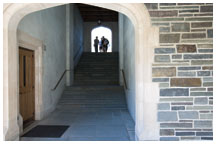
|
November 21, 2007: From the Editor
A collegiate gothic archway connecting Whitman’s two courtyards. (Ricardo Barros) |
The opening of Whitman College this fall was news not just to the University, which marked a milestone in student life, but also in the architecture world, where Whitman advanced a heated discussion over the place of collegiate gothic buildings on contemporary campuses. Beginning on page 18, PAW offers photos of Whitman College that might help you make your own decisions about the buildings and their message.
On campus, there was near-universal agreement that the $136 million college’s design and execution, masterminded by architect Demetri Porphyrios *80, were perfectly suited to a Princeton residential complex. Off campus, some reviews were more circumspect. Catesby Leigh ’79 gave a relatively favorable review in The Wall Street Journal, praising the quality of the masonry, the thick walls built to last centuries, the “variety and intricacy in the massing and scale,” and siting that transformed the home of the Pagoda tennis courts into something that “echoes in the imagination as a medieval town facing wilderness on one side and civilization on the other.” But he criticized Whitman’s “inadequate decoration,” a sentiment that Porphyrios noted with mild disdain several times during a tour.
The Chronicle of Higher Education asked how to judge such construction. At Cambridge and Oxford universities, “the elements of what strike us as quirky and delightful quadrangles were added one at a time over the course of decades or centuries, not built all at once,” the Chronicle said, blasting the “truly awful” buildings that have sprung up at American colleges in the style’s name. “Whitman is a series of clumsy shoe boxes compared with the 1547 chapel at Cambridge’s King’s College, but frankly, it seems like a masterpiece compared with any number of 20th-century collegiate gothic buildings,” it said. “Where do we go from here?”
Where Princeton goes from here is in a totally different direction, across campus to the Frank Gehry-designed Lewis Science Library, now scheduled to open next fall. Since the announcement that Gehry — designer of the titanium-topped Guggenheim Museum in Bilbao, Spain — would create a building at Princeton, University administrators have trumpeted the appropriateness they see in building both a residential college steeped in tradition and a science library that screams cutting-edge.
Without mentioning Gehry, however, Porphyrios makes it clear what he thinks of that prospect. In a collection of musings collected by Princeton’s communications office, Porphyrios repeatedly and harshly critiques the kind of architecture for which Gehry is famous, taking aim at everything from the long-term costs of modern architecture to its appearance to what he sees as its message. “Building in Oxford, Cambridge, or Princeton, one cannot but be drawn to the collegiate traditions of the universities and the seminal educational role they have in our society,” he said. “To opt for fashionable curves and lines is either arrogant or, at best, futile.”
Watch PAW next year for Gehry’s take on the subject. ![]()
![]()
Marilyn H. Marks *86
mmarks@princeton.edu

